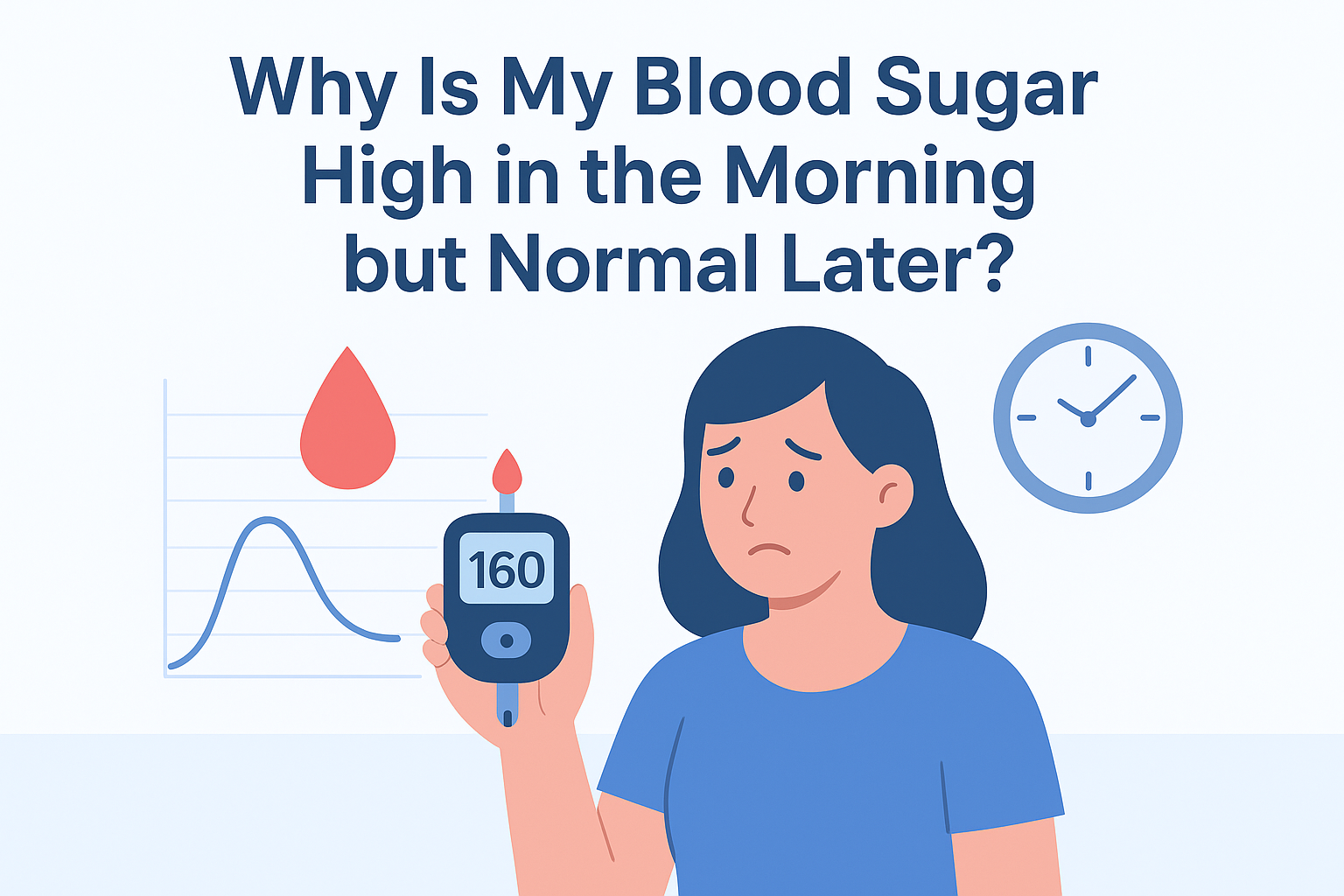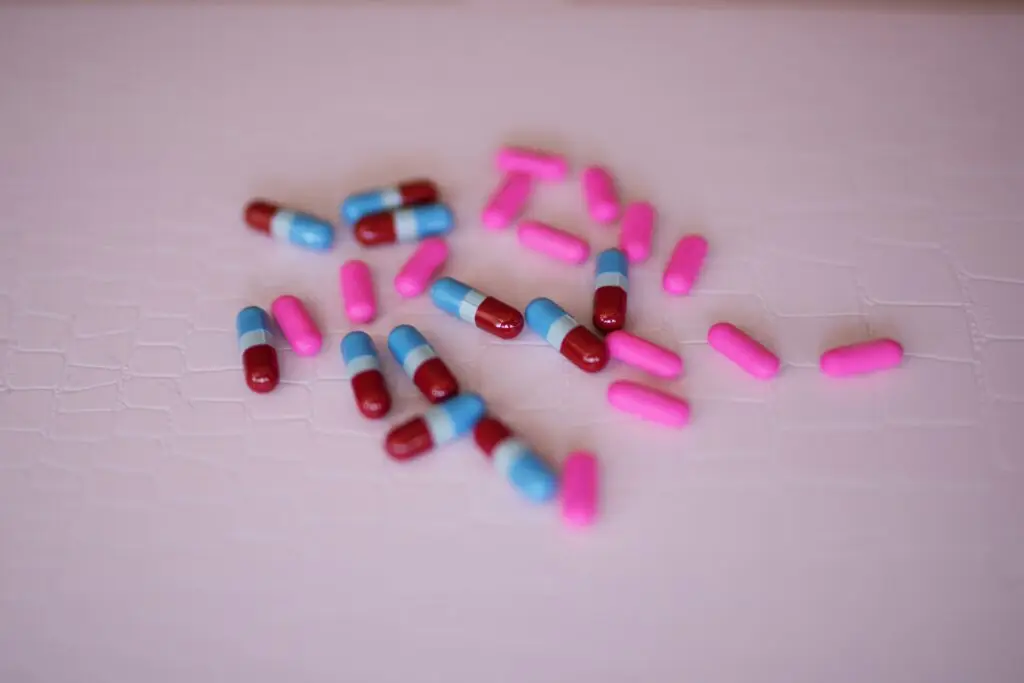
⚠️ Affiliate Disclaimer: This post may contain affiliate links, which means I may earn a small commission — at no extra cost to you — if you make a purchase through one of these links. I only recommend products or services I genuinely trust and believe can provide value. Thank you for supporting My Medical Muse!
7 Clear Reasons Why Your Blood Sugar Is High in the Morning but Normal Later
Many people with diabetes or prediabetes notice a frustrating pattern, blood sugar is high when they wake up but normal later in the day.
You may go to bed with a perfect reading, only to wake up wondering what went wrong overnight. If this sounds familiar, you’re not alone. Morning glucose spikes are one of the most common and confusing issues in blood sugar management.
In this guide, we’ll break down exactly why blood sugar rises in the morning, how to tell which cause applies to you, and what you can do to fix it naturally or with medical help.
The Basics: Understanding Morning Blood Sugar Patterns
Your body’s blood sugar levels naturally rise and fall throughout the day but mornings are special, they’re influenced by hormones, liver function, sleep quality, and even what you ate last night.
When you first wake up, several biological processes kick in to prepare your body for the day.
These include the release of cortisol, growth hormone, adrenaline, and glucagon, all of which raise blood sugar.
This is normal, even for healthy people. However, if you have insulin resistance or diabetes, your body can’t manage this surge effectively, leading to a morning glucose spike.
Common Reasons Your Blood Sugar Is High in the Morning
Let’s look at the major causes and how to tell which one is happening to you.
1. The Dawn Phenomenon (Dawn Effect)
The dawn phenomenon is a natural rise in blood sugar that occurs between 2 AM and 8 AM caused by your body’s circadian rhythm. As you sleep, your body releases cortisol, growth hormone, and glucagon to help you wake up and have energy for the day. These hormones tell your liver to release glucose into the bloodstream.
In healthy individuals, insulin automatically balances this out, but if you have insulin resistance or diabetes, your body doesn’t make enough insulin or doesn’t use it effectively, so blood sugar rises too high.
Typical Signs:
- Normal blood sugar before bed
- No overnight eating
- High fasting glucose upon waking
- Blood sugar drops back to normal by mid-morning
What helps:
- Having a lower-carb dinner
- Going for a short evening walk
- Avoiding late-night snacks, especially sugary or starchy ones
- Talking to your doctor about adjusting basal insulin if you’re on medication
2. The Somogyi Effect (Rebound Hyperglycemia)
The Somogyi effect happens when your blood sugar drops too low overnight, and your body overcompensates by releasing stored glucose, causing a high reading in the morning.
This is less common but still possible, especially for people on insulin or glucose-lowering medications.
Typical Signs:
- You had low blood sugar at night (possibly causing restless sleep, sweating, or nightmares)
- You wake up with high glucose despite not eating
- You may feel tired, shaky, or irritable upon waking
How to confirm:
Check your blood sugar at 2-3 AM for a few nights:
- If it’s low, then rebounds high in the morning – Somogyi effect.
- If it’s normal or rising, it’s more likely the dawn phenomenon.
What helps:
- Eat a small balanced bedtime snack (protein and healthy fat)
- Avoid excessive evening insulin or meds
- Work with your healthcare provider to adjust nighttime doses
3. Late-Night Eating or High-Carb Dinners
Even if you don’t have dawn or Somogyi effects, what you eat before bed plays a huge role.
Heavy dinners, especially those rich in refined carbs (white rice, bread, pasta, desserts) can cause your blood sugar to stay high for hours.
Since digestion slows down at night, your glucose may peak during sleep and still be elevated by morning.
Typical Signs:
- High fasting glucose
- You ate dinner or snacks late (after 8-9 PM)
- You feel bloated or sluggish overnight
What helps:
- Finish dinner 3-4 hours before bed
- Focus on protein, fiber, and non-starchy vegetables at dinner
- Limit high-GI carbs and sugary drinks in the evening
4. Insulin Resistance and Liver Glucose Dumping
Your liver acts as a glucose storage tank. During the night, it releases sugar into your bloodstream to maintain normal levels while fasting. However, in people with insulin resistance, the liver doesn’t hear insulin’s signal to stop releasing sugar, so it keeps pumping glucose out even when it’s not needed.
Typical Signs:
- Morning glucose high, stays moderate all day
- HbA1C or fasting glucose trending upward
- Often tied to belly fat, metabolic syndrome, or PCOS
What helps:
- Increase insulin sensitivity through:
- Resistance training (even 15-20 minutes daily)
- Walking after meals
- Reducing added sugars and refined carbs
- Losing even 5-10% of body weight, if overweight
5. Cortisol Spikes from Stress or Poor Sleep
Cortisol, your “stress hormone” directly increases blood sugar by stimulating glucose production in the liver. If you’re under chronic stress or sleep poorly, your cortisol levels stay elevated, especially early in the morning.
Typical Signs:
- You wake up anxious or wired
- Poor sleep quality (tossing, turning, or waking frequently)
- Morning glucose high despite clean eating
- Normal readings later once you’re active
What helps:
- Prioritize 7-8 hours of quality sleep
- Practice stress-reducing activities (deep breathing, journaling, stretching)
- Avoid caffeine too late in the day
- Consider adaptogenic herbs (like ashwagandha or rhodiola, with your doctor’s approval)
6. Medication Timing or Missed Doses
If you’re using insulin, metformin, GLP-1 agonists, or other glucose-lowering drugs, missing or mistiming doses can cause fasting spikes.
What helps:
- Track doses with an app or reminder
- Never adjust your medication timing without consulting your provider
- Review your glucose trends with your doctor every 3-6 months
7. The Role of Circadian Rhythm
Your body’s internal clock, the circadian rhythm regulates nearly every hormone, including insulin and cortisol. If your rhythm is disrupted (from shift work, jet lag, or inconsistent sleep), your glucose control suffers.
Research shows that people who sleep irregularly or eat late at night have 20-30% higher fasting glucose than those with consistent routines.
Fix your rhythm by:
- Sleeping and waking at consistent times
- Avoiding screens and bright light 1 hour before bed
- Getting morning sunlight exposure to reset your biological clock
How to Identify Your Exact Cause
You can usually figure out why your morning blood sugar is high by doing a simple self-check experiment for 3-5 nights.
| Time | What to Do | What It Tells You |
| Before bed | Check your glucose | Establish baseline |
| 2-3 AM | Optional: check again | Low (Somogyi) Normal/High (Dawn or liver effect) |
| Upon waking | Record fasting glucose | Confirms morning spike |
| After breakfast | Track if levels normalize | Indicates body’s insulin response |
You can also use a Continuous Glucose Monitor (CGM) for clearer insight, these devices (like Dexcom, Freestyle Libre, or Levels) track your glucose all night and reveal your patterns visually.
What You Eat at Night Matters A Lot
The last meal before bed has a powerful effect on morning glucose.
Here’s how to build a blood sugar-friendly dinner:
Do:
- Include protein (chicken, fish, tofu, eggs)
- Add healthy fats (olive oil, avocado, nuts)
- Load up on fiber-rich vegetables (broccoli, spinach, green beans)
- Use low-GI carbs if desired (quinoa, lentils, sweet potato)
Avoid:
- White rice, bread, pasta
- Sugary desserts
- Soda or juice
- Alcohol right before bed
If you’re hungry later, have a small protein-based snack e.g, Greek yogurt, a boiled egg, or a few nuts.
Movement and Evening Activity
Physical activity improves insulin sensitivity and helps your body use glucose efficiently.
A simple 10-15 minute walk after dinner can reduce next-morning fasting glucose by up to 15-20 mg/dL, according to multiple studies.
Other great options:
- Light stretching before bed
- Yoga or gentle resistance training
- Avoid lying down immediately after eating
Don’t Forget Hydration
Dehydration raises blood sugar because it concentrates glucose in your blood and reduces your kidneys’ ability to clear it.
Aim for:
- 2-3 liters of water daily (depending on your body size)
- Herbal teas (especially at night) instead of sugary drinks
- Electrolyte-rich options if you exercise or sweat heavily
Hidden Factors You Might Not Realize
Here are a few less obvious reasons your morning blood sugar might be high:
- Alcohol before bed: Can cause early-night lows and rebound highs.
- Caffeine sensitivity: late coffee can elevate cortisol.
- Pain or inflammation: Trigger stress hormones overnight.
- Hormonal changes: Especially during menstrual cycles or menopause.
- Thyroid issues: An underactive or overactive thyroid can disrupt glucose control.
If you’ve optimized your diet and sleep but still have morning highs, ask your doctor to check thyroid and cortisol levels or review your medication plan.
When to Be Concerned
Occasional morning highs aren’t dangerous but consistently elevated fasting glucose (above 126 mg/dL) can indicate poor overnight control and higher long-term A1C.
You should contact your healthcare provider if:
- Fasting glucose stays above 130 mg/dL for more than 5-7 days
- You experience nighttime hypoglycemia symptoms (sweating, shaking, confusion)
- Your A1C rises despite consistent effort
- You’re unsure if it’s dawn phenomenon or medication-related
Medical Treatment Options
If you’ve already fine-tuned your diet, exercise, and sleep but still wake up with elevated glucose levels, your healthcare provider may recommend medical adjustments to help restore better overnight blood sugar control. These treatments are designed to complement not replace your healthy habits.
1. Basal Insulin Adjustment:
For people using insulin therapy, the timing and dosage of basal (long-acting) insulin play a crucial role in keeping fasting glucose within range.
If your blood sugar consistently rises overnight or upon waking, it may mean your current dose wears off too early or isn’t strong enough to counteract the liver’s glucose release.
Your doctor may:
Adjust your injection time (e.g., moving it to bedtime instead of dinner)
Modify your dose or switch to a longer-acting insulin formula (such as insulin glargine U-300 or insulin degludec)
Recommend a split dosing schedule in some cases for smoother 24-hour coverage
Never change your insulin dose or timing on your own. Always discuss adjustments with your healthcare provider or diabetes educator to prevent hypoglycemia (low blood sugar).
2. Metformin at Night:
Metformin remains one of the most widely used and trusted medications for type 2 diabetes.
One of its key benefits is reducing the liver’s overnight glucose production, which makes it especially effective for people struggling with high fasting blood sugar.
If you already take metformin, your doctor might suggest:
Taking your dose in the evening rather than the morning.
Switching to an extended-release (XR) version to provide smoother overnight coverage.
Combining metformin with other agents for additional support if fasting levels remain high
Many patients find that evening metformin dosing helps curb dawn-related glucose spikes and improves overall A1C levels.
3. Newer Medications: GLP-1 and SGLT2 Inhibitors:
Modern diabetes management includes innovative drug classes that go beyond traditional glucose control.
GLP-1 receptor agonists (like Ozempic, Trulicity, or Mounjaro) and SGLT2 inhibitors (like Jardiance or Farxiga) offer multiple benefits:
Lower fasting and post-meal blood sugar
Reduce appetite and support weight loss
Lower cardiovascular risk in people with diabetes or metabolic syndrome
Improve insulin sensitivity over time
For those who wake up with high fasting glucose despite lifestyle improvements, these medications can provide significant metabolic balance, sometimes even allowing for dose reductions in insulin or other agents.
Your doctor will evaluate which option best fits your specific profile, health history, and insurance coverage.
4. Continuous Glucose Monitoring (CGM):
A Continuous Glucose Monitor (CGM) can transform how you manage your blood sugar.
These small wearable devices (like Dexcom, Freestyle Libre, or Medtronic Guardian) track glucose levels 24/7, including while you sleep.
CGMs help you and your healthcare provider:
Identify overnight trends (dawn phenomenon vs. rebound spikes)
See how food, stress, or medication timing affect your glucose.
Make data-driven medication adjustments
Catch nighttime lows early and improve overall glucose stability
For anyone trying to understand why fasting numbers remain high despite best efforts, CGM insights can be game-changing.
5. Combination or Tailored Therapies:
In some cases, your provider may recommend combining medications, for example:
Metformin and GLP-1 agonist for insulin resistance and appetite control.
Basal insulin and SGLT2 inhibitor for smoother fasting numbers and heart protection.
Metformin and DPP-4 inhibitor for moderate glucose elevations without hypoglycemia risk.
The goal of treatment is not just to lower numbers, but to achieve stable, consistent glucose control that supports your energy, mood, and long-term health.
Warning: Never change your insulin dose, timing, or medication routine without consulting your healthcare professional. Even small adjustments can lead to unintended side effects or hypoglycemia if not properly monitored.
Instead, use your blood sugar logs or CGM reports to have a data-backed conversation with your doctor. Together, you can personalize a plan that works for your body’s rhythm and keeps your mornings on track.
Natural Strategies to Try
If you prefer natural or lifestyle-based approaches, here’s what research supports:
- Apple cider vinegar before bed (1 tbsp in water) may slightly reduce fasting glucose.
- Magnesium-rich foods (spinach, pumpkin seeds, almonds) support insulin function.
- Chromium and berberine supplements can improve insulin sensitivity, but always check with your doctor first.
- Mindfulness, meditation, and gentle yoga lower cortisol, helping smooth out morning spikes.
Realistic Expectations
Your goal isn’t to eliminate every single glucose spike, it’s to understand your body’s pattern and keep average levels steady.
It may take 2-3 weeks of tracking, experimenting, and adjusting to see a clear improvement.
Be patient and celebrate small wins like a 10-15 mg/dL improvement in fasting numbers.
Key Takeaways
| Issue | What Happens | How to Fix It |
| Dawn Phenomenon | Hormones raise glucose before waking | Eat earlier, exercise at night, adjust insulin timing |
| Somogyi Effect | Overnight low – rebound high | Add bedtime snack, adjust meds |
| Late-night eating | Slow digestion- sustained glucose | Avoid carbs before bed |
| Liver dumping | Insulin resistance triggers glucose release | Improve insulin sensitivity |
| Poor sleep/stress | Cortisol spikes blood sugar | Sleep hygiene, stress control |
Final Thoughts
If your blood sugar is high in the morning but normal later, your body is sending you a message, not that something is “wrong,” but that something in your overnight routine, hormone cycle, or insulin response needs a gentle recalibration.
Morning glucose spikes are incredibly common, even among people who eat well and take their health seriously. The key is to understand that your overnight metabolism is just as important as your daytime habits. What your body does while you sleep can determine how balanced, energized and clear-headed you feel when you wake up.
Most people can see significant improvements within a few weeks by paying closer attention to small daily choices:
- Tracking nighttime glucose trends
Use a glucometer or continuous glucose monitor (CGM) to learn what your blood sugar does between midnight and morning. This simple data can reveal powerful patterns, whether it’s a dawn effect, rebound spike, or late-night meal response. - Adjusting meal timing and content, finishing dinner earlier, reducing refined carbs, and adding more protein or healthy fats before bed can dramatically smooth your morning numbers. Think of your evening plate as a setup for tomorrow’s success.
- Improving sleep and managing stress
Restful sleep and lower cortisol levels are game changers. When your mind and body rest deeply, your hormones stay in sync, your liver works efficiently, and your insulin performs better. A calmer night leads to a calmer morning both emotionally and metabolically. - Staying active consistently,
Even light evening movement like a short walk or stretching routine enhances insulin sensitivity overnight. Over time, this keeps your fasting glucose lower and your energy steadier throughout the day.
These aren’t drastic medical interventions; they’re simple, sustainable lifestyle adjustments that let your body function the way it’s designed to. Ultimately, remember this, what happens overnight is just as important as what you eat during the day. Your body doesn’t stop working while you sleep, it’s healing, balancing hormones, and managing energy reserves. The goal isn’t perfection, but awareness.
By learning your body’s unique rhythm, tracking how your choices affect your numbers, and making small, targeted changes, you can wake up to steadier, healthier blood sugar every single morning.
Over time, those steady mornings add up to something bigger, better energy, sharper focus, improved mood, and a lower risk of long-term complications.
Your mornings can be a reflection of your progress and every good morning is proof that your body is learning to work with you, not against you.
👩⚕️ Need Personalized Health Advice?
Get expert guidance tailored to your unique health concerns through MuseCare Consult. Our licensed doctors are here to help you understand your symptoms, medications, and lab results—confidentially and affordably.
👉 Book a MuseCare Consult NowRelated Blog Post You Might Like:
- 7 Surprising Reasons Why Your Blood Sugar Spikes After Eating Low-Carb Meals
- 10 Proven Benefits of Nutritional Counseling for Diabetes Management
- Can Intermittent Fasting Help Type 2 Diabetes? 9 Powerful Facts
- 10 Sneaky Symptoms of Prediabetes in Women Over 40 You Can’t Ignore
- 7 Clear Reasons Why Your Blood Sugar Is High in the Morning but Normal Later
- Can Dehydration Raise Your Blood Pressure? 10 Powerful Reasons Why
- 10 Proven Tips on How to Interpret Hemoglobin A1c Levels Accurately


